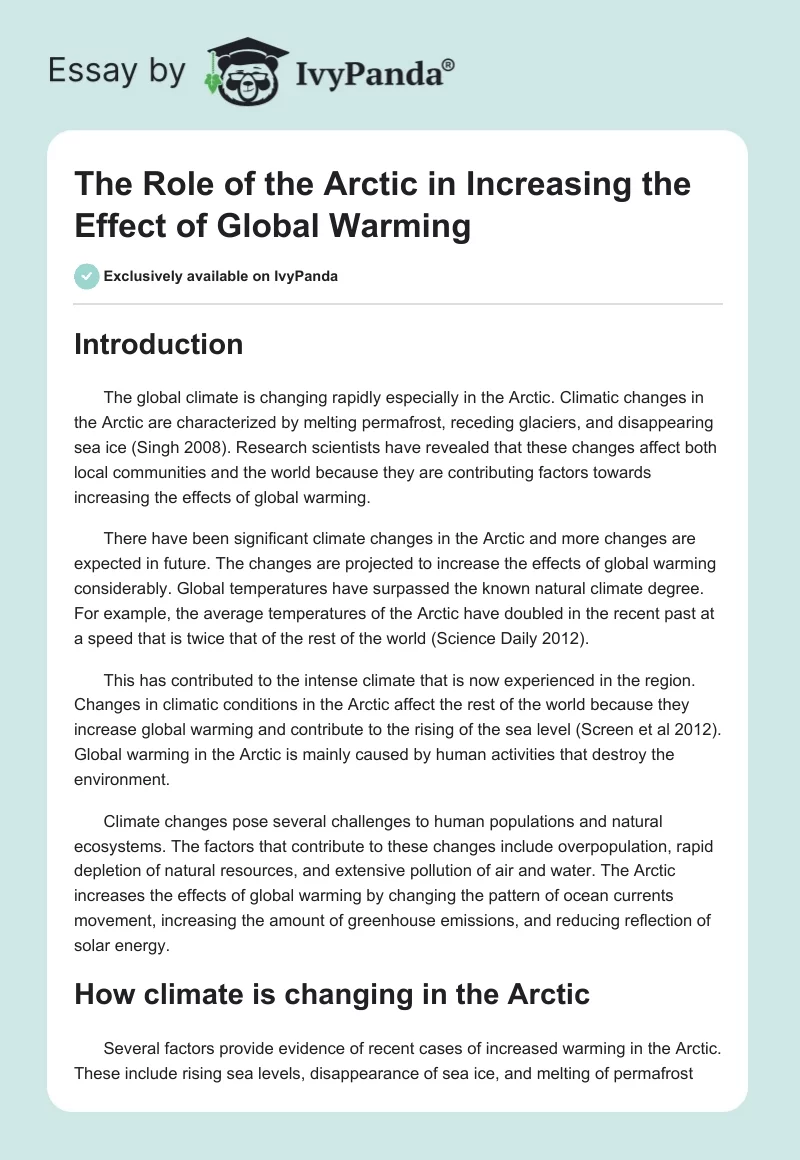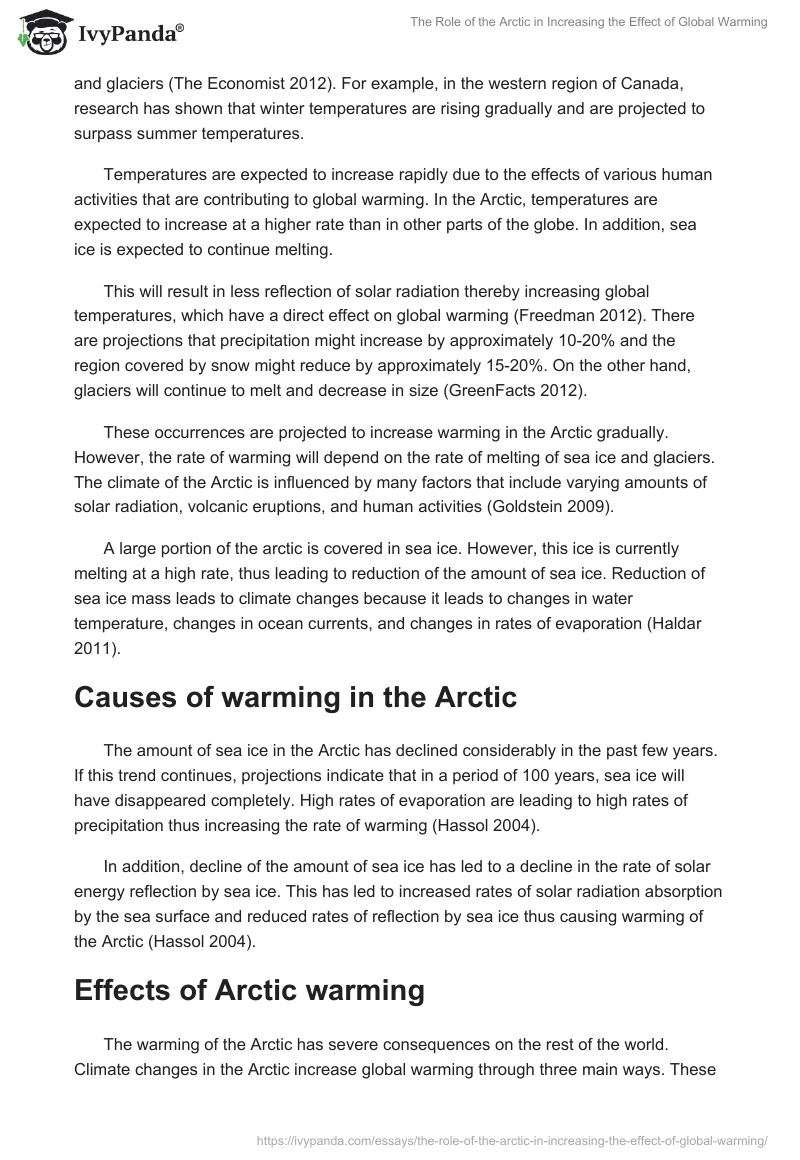Introduction
The global climate is changing rapidly especially in the Arctic. Climatic changes in the Arctic are characterized by melting permafrost, receding glaciers, and disappearing sea ice (Singh 2008). Research scientists have revealed that these changes affect both local communities and the world because they are contributing factors towards increasing the effects of global warming.
There have been significant climate changes in the Arctic and more changes are expected in future. The changes are projected to increase the effects of global warming considerably. Global temperatures have surpassed the known natural climate degree. For example, the average temperatures of the Arctic have doubled in the recent past at a speed that is twice that of the rest of the world (Science Daily 2012).
This has contributed to the intense climate that is now experienced in the region. Changes in climatic conditions in the Arctic affect the rest of the world because they increase global warming and contribute to the rising of the sea level (Screen et al 2012). Global warming in the Arctic is mainly caused by human activities that destroy the environment.
Climate changes pose several challenges to human populations and natural ecosystems. The factors that contribute to these changes include overpopulation, rapid depletion of natural resources, and extensive pollution of air and water. The Arctic increases the effects of global warming by changing the pattern of ocean currents movement, increasing the amount of greenhouse emissions, and reducing reflection of solar energy.
How climate is changing in the Arctic
Several factors provide evidence of recent cases of increased warming in the Arctic. These include rising sea levels, disappearance of sea ice, and melting of permafrost and glaciers (The Economist 2012). For example, in the western region of Canada, research has shown that winter temperatures are rising gradually and are projected to surpass summer temperatures.
Temperatures are expected to increase rapidly due to the effects of various human activities that are contributing to global warming. In the Arctic, temperatures are expected to increase at a higher rate than in other parts of the globe. In addition, sea ice is expected to continue melting.
This will result in less reflection of solar radiation thereby increasing global temperatures, which have a direct effect on global warming (Freedman 2012). There are projections that precipitation might increase by approximately 10-20% and the region covered by snow might reduce by approximately 15-20%. On the other hand, glaciers will continue to melt and decrease in size (GreenFacts 2012).
These occurrences are projected to increase warming in the Arctic gradually. However, the rate of warming will depend on the rate of melting of sea ice and glaciers. The climate of the Arctic is influenced by many factors that include varying amounts of solar radiation, volcanic eruptions, and human activities (Goldstein 2009).
A large portion of the arctic is covered in sea ice. However, this ice is currently melting at a high rate, thus leading to reduction of the amount of sea ice. Reduction of sea ice mass leads to climate changes because it leads to changes in water temperature, changes in ocean currents, and changes in rates of evaporation (Haldar 2011).
Causes of warming in the Arctic
The amount of sea ice in the Arctic has declined considerably in the past few years. If this trend continues, projections indicate that in a period of 100 years, sea ice will have disappeared completely. High rates of evaporation are leading to high rates of precipitation thus increasing the rate of warming (Hassol 2004).
In addition, decline of the amount of sea ice has led to a decline in the rate of solar energy reflection by sea ice. This has led to increased rates of solar radiation absorption by the sea surface and reduced rates of reflection by sea ice thus causing warming of the Arctic (Hassol 2004).
Effects of Arctic warming
The warming of the Arctic has severe consequences on the rest of the world. Climate changes in the Arctic increase global warming through three main ways. These include interfering with the reflection of solar energy, changing pattern of flow of ocean currents, and increasing greenhouse emissions. The three mechanisms increase global warming in different ways.
Effect of Arctic warming on reflection of solar radiation
One of the reasons why the Arctic is so cold is because of reflection of solar energy by sea ice and snow (Johansson 2011). Sea ice and snow are white. Therefore, they reflect solar energy back to space. Increase in air temperatures discourages presence of snow and ice. Therefore, snow and ice are formed during the close of autumn season and melt during the start of spring.
This means that a large part of land is covered by snow and ice for most part of the year. This results in warming of the land surface, which results in a “positive feedback loop” which is responsible for increase in the rate of warming (Houghton 2004). This explains why climate change is more rapid in the Arctic than in other parts of the globe.
Warming of the Arctic consequently leads to expansion of forests towards the north covering regions that currently comprise tundra (Johansson 2011). Forests are usually dense and mask the snow that is present on the ground. This reduces the rate of sunlight reflection thus increasing warming.
However, the increasing rate of warming may be moderated by the ability of forests to absorb a large amount of carbon dioxide from the atmosphere. The tundra region reflects more solar energy than forests. Therefore, replacement of tundra by forests reduces reflection of solar energy.
Reduction in reflectivity of solar energy increases global warming because more solar energy is retained on the earth surface instead of being reflected back to space (Houghton 2004). In addition, soot that covers snow and ice in the Arctic reduces their ability to reflect solar energy. Some soot is also found in the atmosphere and absorbs some solar energy thus increasing warming.
Effect of Arctic warming on ocean currents
Ocean currents increase the effects of global warming significantly. The Arctic has contributed in increasing the effects of global warming by altering the pattern of ocean currents movement (Keskitalo 2012). The movement of ocean waters is one of the ways through which solar energy is deflected towards the poles.
This movement is regulated by changes in heat and salt content of water through a process known as thermopile circulation. The Gulf Stream current is responsible for most of the moisture content that forms precipitate in the northwestern regions of Europe.
Climate change in the Arctic leads to movement of freshwater to the Arctic due to reduction of sea ice and melting of glaciers (Keskitalo 2012). This slows down the process of thermopile circulation, which has adverse effects on global climate.
It facilitates the buildup of carbon dioxide in the atmosphere, which leads to long-lasting effects of global warming (Saddleback 2009). In addition, it causes a rise of the sea level due to high rates of thermal expansion (Lemke & Jacobi 2012). These processes contribute in increasing the effects of global warming.
Effect of warming on greenhouse emissions
The Arctic affects global climate change by modifying the exchange of greenhouse gases between the atmosphere and the soils (NASA 2003). This process is affected by warming of seawater and air. The permafrost contains high quantities of carbon in the form of organic matter.
When this organic matter decomposes, carbon dioxide is released into the atmosphere as a greenhouse gas (Parry 2012). The rate of organic matter decomposition is increased by high temperatures. High decomposition rates lead to high rates of gas production and feedback loop that cause more warming.
This process may be moderated by increase in forest density that could increase the rate of carbon absorption from the atmosphere (Robinson & Moore 2012). Permafrost found in the Arctic contains large amounts of methane. Increase in temperatures lead to increase in rate of methane release, which contributes to warming (Nihoul & Kostianoi 2009).
Research has shown that the effect of the Arctic Ocean on regulating the amount of carbon is limited due to presence of sea ice. This contributes to global warming. The Arctic may contribute significantly in reducing the amount of carbon dioxide in the atmosphere.
Melting of glaciers and sea ice exposes a large portion of the sea surface to the atmosphere (Oceans North 2012). This leads to more absorption of carbon dioxide by water and components of the marine ecosystems. However, the area that is covered is insufficient to make significant changes in reduction of atmospheric carbon dioxide.
Conclusion
The Arctic has a significant influence on global climate, especially global warming. A large portion of the arctic is covered in snow. Therefore, most of the solar energy from the sun is reflected from land and water surfaces. However, recent changes in the Arctic are increasing the effects of global warming considerably.
These changes include modification of flow of ocean currents, reduction in reflectivity of sunlight, and increase in greenhouse gas released to the atmosphere. Climate changes in the Arctic result from melting of sea ice and glaciers, disappearance of permafrost, and expansion of forest cover.
The Arctic increases the effects of global warming through altering the pattern of ocean currents movement. Change in patterns of ocean currents movements alters the process of thermopile circulation. This leads to movement of freshwater to the Arctic due to reduction of sea ice and melting of glaciers. In addition, it slows down the process of thermopile circulation, which has adverse effects on global climate.
Reduction in reflectivity of sunlight leads to high rates of solar energy absorption leading to global warming. This is caused by melting of sea ice and glaciers. On the other hand, low absorption of carbon dioxide leads to increase in levels of atmospheric carbon dioxide.
In addition, release of methane increases the amount of greenhouse gases thus leading to global warming. The Arctic increases the effects of global warming by changing the pattern of ocean currents movement, increasing the amount of greenhouse emissions, and by reducing reflectivity of sunlight.
References
Freedman, A. 2012, Arctic Warming is Altering Weather Patterns, Study Shows. Web.
GreenFacts. Arctic Climate Change. Web.
Goldstein, N. 2009, Global Warming, New York, Infobase Publishing.
Haldar, I. 2011, Global Warming: The Causes and Consequences, Mind Melodies, New York.
Hassol, S. 2004, Impacts of a Warming Arctic: Arctic Climate Impact Assessment, Cambridge University Press, New York.
Houghton, J. 2004, Global Warming the Complete Briefing, Cambridge University Press, New York.
Johansson, M. 2011, Effects of Climate Change in the Arctic More Extensive than Expected. Web.
Keskitalo, C. 2012, Climate Change and Globalization in the Arctic: An Integrated Approach to Vulnerability Assessment, Routledge, New York.
Lemke, P. & Jacobi H. 2012, Arctic Climate Change, Springer, New York.
NASA. (2003). Recent Warming of Arctic may Affect Worldwide Climate. Web.
Nihoul, J & Kostianoi, A 2009, Influence of Climate Change on the Changing Arctic and Sub-Arctic Conditions, Springer, New York.
Oceans North 2012, Climate Change: Global Effects of Arctic Warming. Web.
Oceans North 2012, Arctic Challenges. Web.
Parry, W. 2012. 5 Ways Rapid Warming is Changing the Arctic. Web.
Robinson, G. & Moore, L. 2012, Adapting to Climate Change, Nova Science Publishing Incorporated, New York.
Saddleback 2009, Global Warming Differentiated Text, Saddleback Educational Publishers, New York.
Singh, K. 2008, Global Warming in the 21st Century: Causes Effects and Future. Coronet Books Incorporated, New York.
Science Daily 2012, Arctic Warming Linked to Combination of Reduced Sea Ice and Global Atmospheric Warming. Web.
Screen, C., Deser, I., & Simmons, I. 2012, Local and Remote Controls on Observed Arctic Warming, Geophysical Research Letters, vol 39 no.10, pp.256-175
The Economist 2012, Global Warming: the Vanishing North. Web.


